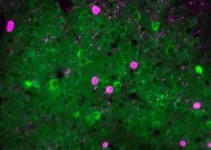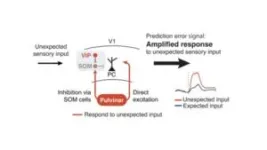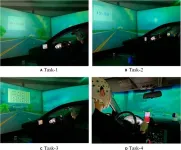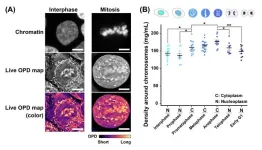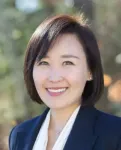(Press-News.org) Researchers have discovered how two brain areas, neocortex and thalamus, work together to detect discrepancies between what animals expect from their environment and actual events. These prediction errors are implemented by selective boosting of unexpected sensory information. These findings enhance our understanding of predictive processing in the brain and could offer insights into how brain circuits are altered in autism spectrum disorders (ASDs) and schizophrenia spectrum disorders (SSDs).
The research, published today in Nature, outlines how scientists at the Sainsbury Wellcome Centre at UCL studied mice in a virtual reality environment to take us a step closer to understanding both the nature of prediction error signals in the brain as well as the mechanisms by which they arise.
“Our brains constantly predict what to expect in the world around us and the consequences of our actions. When these predictions turn out wrong, this causes strong activation of different brain areas, and such prediction error signals are important for helping us learn from our mistakes and update our predictions. But despite their importance, surprisingly little is known about the neural circuit mechanisms responsible for their implementation in the brain,” explained Professor Sonja Hofer, Group Leader at SWC and corresponding author on the paper.
To study how the brain processes expected and unexpected events, the researchers placed mice in a virtual reality environment where they could navigate along a familiar corridor to get to a reward. The virtual environment enabled the team to precisely control visual input and introduce unexpected images on the walls. By using a technique called two-photon calcium imaging, the researchers were able to record the neural activity from many individual neurons in primary visual cortex, the first area in our neocortex to receive visual information from the eyes.
“Previous theories proposed that prediction error signals encode how the actual visual input is different from expectations, but surprisingly we found no experimental evidence for this. Instead, we discovered that the brain boosts the responses of neurons that have the strongest preference for the unexpected visual input. The error signal we observe is a consequence of this selective amplification of visual information. This implies that our brain detects discrepancies between predictions and actual inputs to make unexpected events more salient” explained Dr Shohei Furutachi, Senior Research Fellow in the Hofer and Mrsic-Flogel labs at SWC and first author on the study.
To understand how the brain generates this amplification of the unexpected sensory input in the visual cortex, the team used a technique called optogenetics to inactivate or activate different groups of neurons. They found two groups of neurons that were important for causing the prediction error signal in the visual cortex: vasoactive intestinal polypeptide (VIP)-expressing inhibitory interneurons in V1 and a thalamic brain region called the pulvinar, which integrates information from many neocortical and subcortical areas and is strongly connected to V1. But the researchers found that these two groups of neurons interact in a surprising way.
“Often in neuroscience we focus on studying one brain region or pathway at a time. But coming from a molecular biology background, I was fascinated by how different molecular pathways synergistically interact to enable flexible and contextual regulation. I decided to test the possibility that cooperation could be occurring at the level of neural circuits, between VIP neurons and the pulvinar,” explained Dr Furutachi.
And indeed, Dr Furutachi’s work revealed that VIP neurons and pulvinar act synergistically together. VIP neurons act like a switch board: when they are off, the pulvinar suppresses activity in the neocortex, but when VIP neurons are on, the pulvinar can strongly and selectively boost sensory responses in the neocortex. The cooperative interaction of these two pathways thus mediates the sensory prediction error signals in visual cortex.
The next steps for the team are to explore how and where in the brain the animals’ predictions are compared with the actual sensory input to compute sensory prediction errors and how prediction error signals drive learning. They are also exploring how their findings could help contribute to understanding ASDs and SSDs.
“It has been proposed that ASDs and SSDs both can be explained by an imbalance in the prediction error system. We are now trying to apply our discovery to ASDs and SSDs model animals to study the mechanistic neural circuit underpinnings of these disorders,” explained Dr Furutachi.
This research was funded by the Sainsbury Wellcome Centre Core Grant from the Gatsby Charity Foundation and Wellcome (219627/Z/19/Z and 090843/F/09/Z); a Wellcome Investigator Award (219561/Z/19/Z); the Gatsby Charitable Foundation (GAT3212 and GAT3361); the Wellcome Trust (090843/E/09/Z and 217211/Z/19/Z); European Research Council (HigherVision 337797; NeuroV1sion 616509); the SNSF (31003A 169525); Biozentrum core funds (University of Basel).
Source:
Read the full paper in Nature: ‘Cooperative thalamocortical circuit mechanism for sensory prediction errors’ DOI: 10.1038/s41586-024-07851-w
Media contact:
For more information or to speak to the researchers involved, please contact:
April Cashin-Garbutt, Head of Research Communications and Engagement, Sainsbury Wellcome Centre
E: a.cashin-garbutt@ucl.ac.uk T: +44 (0)20 3108 8028
About the Sainsbury Wellcome Centre
The Sainsbury Wellcome Centre (SWC) brings together world-leading neuroscientists to generate theories about how neural circuits in the brain give rise to the fundamental processes underpinning behaviour, including perception, memory, expectation, decisions, cognition, volition and action. Funded by the Gatsby Charitable Foundation and Wellcome, SWC is located within UCL and is closely associated with the Faculties of Life Sciences and Brain Sciences. For further information, please visit: www.sainsburywellcome.org
END
Prioritizing the unexpected: New brain mechanism uncovered
Neuroscientists show how the brain implements responses to unexpected events
2024-08-28
ELSE PRESS RELEASES FROM THIS DATE:
More people at risk of hereditary heart disease than thought
2024-08-28
More people in the UK are at risk of a hereditary form of cardiac amyloidosis, a potentially fatal heart condition, than previously thought, according to a new study led by researchers at UCL (University College London) and Queen Mary University of London.
The study, published in JAMA Cardiology, used data from the UK Biobank to analyse the genes of 469,789 people in the UK and found that one in 1,000 possessed genetic variants with a likely link to cardiac transthyretin (ATTR) amyloidosis.
Among ...
Breaking open the AI black box, team finds key chemistry for solar energy and beyond
2024-08-28
CHAMPAIGN, Ill. — Artificial intelligence is a powerful tool for researchers, but with a significant limitation: The inability to explain how it came to its decisions, a problem known as the “AI black box.” By combining AI with automated chemical synthesis and experimental validation, an interdisciplinary team of researchers at the University of Illinois Urbana-Champaign has opened up the black box to find the chemical principles that AI relied on to improve molecules for harvesting solar energy.
The result produced light-harvesting molecules four times more stable than ...
Discovery of how blood clots harm brain and body in COVID-19 points to new therapy
2024-08-28
In a study that reshapes what we know about COVID-19 and its most perplexing symptoms, scientists have discovered that the blood coagulation protein fibrin causes the unusual clotting and inflammation that have become hallmarks of the disease, while also suppressing the body’s ability to clear the virus.
Importantly, the team also identified a new antibody therapy to combat all of these deleterious effects.
Published in Nature, the study by Gladstone Institutes and collaborators overturns the prevailing ...
JAMA review highlights advances in kidney cancer research and care
2024-08-28
CHAPEL HILL, North Carolina — New insights into the biology of kidney cancer, including those informed by scientific discoveries that earned a Nobel Prize, have led to advances in treatment and increased survival rates, according to a review by UNC Lineberger Comprehensive Cancer Center’s William Kim, MD, and Tracy Rose, MD, MPH.
Their observations, drawn from a meta-analysis of 89 studies published between January 2013 and January 2024, were published in JAMA Aug. 28.
“The Nobel Prize in Medicine or Physiology in 2019 was awarded ...
new diabetes research in Scientific Reports links blood glucose levels and voice
2024-08-28
NEW YORK/TORONTO – August 28, 2024 – As part of its ongoing exploration of vocal biomarkers and the role they can play in enhancing health outcomes, Klick Labs published a new study in Scientific Reports today – confirming the link between blood glucose levels and voice pitch and opening the door to future advancements in non-invasive glucose monitoring for people living with Type 2 diabetes.
In “Linear Effects of Glucose Levels on Voice Fundamental Frequency in Type 2 diabetes and Individuals with Normoglycemia,” researchers ...
Augmented recognition of distracted driving state based on electrophysiological analysis of brain network
2024-08-28
A research paper by scientists at Beijing Jiaotong University proposed an electrophysiological analysis-based brain network method for the augmented recognition of different types of distractions during driving.
The new research paper, published on Jul. 04 in the journal Cyborg and Bionic Systems, designed and conducted a simulated experiment comprising 4 distracted driving subtasks. Three connectivity indices, including both linear and nonlinear synchronization measures, were chosen to construct the brain network. By computing connectivity strengths and topological features, we explored the potential relationship between brain network configurations and states ...
The functions of actin-binding proteins are regulated by the flexibility and specific helical twists of actin filaments
2024-08-28
Researchers at Kanazawa University report in eLife on deciphering the actin structure-dependent preferential cooperative binding of cofilin.
The actin filament is a double-stranded helical structure formed by intertwining two long-pitch helices, with the distance between crossover points, known as the half helical pitch (HHP), being about 36 nm. A canonical half helix consists of 13 actin protomers, or 6.5 protomer pairs, resulting in a mean axial distance (MAD) of 5.5 nm between two adjacent protomers ...
Team discovers transient rise in depletion attraction contributes to mitotic chromosome condensation
2024-08-28
A team of scientists studying cell division developed a special light microscopy system and used it to analyze the molecular density of cellular environments. Their results provide a novel insight into mitotic chromosome condensation in living human cells.
Their work is published in the journal Proceedings of the National Academy of Sciences (PNAS) on August 27, 2024.
DOI:https://doi.org/10.1073/pnas.2403153121
To carry out their study, the team developed an orientation-independent-differential interference contrast (OI-DIC) microscopy system combined with a confocal ...
nTIDE Deeper Dive August 2024: Disability Employment Disparities Among Students: High School Struggles, College Advancement
2024-08-28
East Hanover, NJ – August 28, 2024 – Young people with disabilities aged 16 to 24 had high school enrollment rates nearly identical to their non-disabled peers, but significantly fewer held jobs during this time. Meanwhile, college students with disabilities were less likely to be enrolled but were slightly more likely to be employed, possibly benefiting from the rise of remote work opportunities in the post-COVID era, according to data shared during the according to last Friday’s National Trends in Disability ...
Rain or shine? How rainfall impacts size of sea turtle hatchlings
2024-08-28
Female sea turtles lay their eggs, cover the nest with sand and then return to the ocean, leaving them to develop and hatch on their own. From nest predators to rising temperatures, odds of survival are bleak. Once hatched and in the ocean, about one in 1,000 make it to adulthood.
Hatchling size matters. Larger hatchlings, which move faster, are more likely to survive because they spend less time on risky beach sands.
Research shows that both air and sand temperatures crucially impact sea turtle hatchlings. Cooler temperatures produce larger, heavier hatchlings with more males, while warmer temperatures ...
LAST 30 PRESS RELEASES:
Breakthrough organic crystalline material repairs itself in extreme cold temperatures, unlocking new possibilities for space and deep-sea technologies
Scientists discover novel immune ‘traffic controller’ hijacked by virus
When tropical oceans were oxygen oases
Positive interactions dominate among marine microbes, six-year study reveals
Safeguarding the Winter Olympics-Paralympics against climate change
Most would recommend RSV immunizations for older and pregnant people
Donated blood has a shelf life. A new test tracks how it's aging
Stroke during pregnancy, postpartum associated with more illness, job status later
American Meteorological Society announces new executive director
People with “binge-watching addiction” are more likely to be lonely
Wild potato follows a path to domestication in the American Southwest
General climate advocacy ad campaign received more public engagement compared to more-tailored ad campaign promoting sustainable fashion
Medical LLMs may show real-world potential in identifying individuals with major depressive disorder using WhatsApp voice note recordings
Early translational study supports the role of high-dose inhaled nitric oxide as a potential antimicrobial therapy
AI can predict preemies’ path, Stanford Medicine-led study shows
A wild potato that changed the story of agriculture in the American Southwest
Cancer’s super-enhancers may set the map for DNA breaks and repair: A key clue to why tumors become aggressive and genetically unstable
Prehistoric tool made from elephant bone is the oldest discovered in Europe
Mineralized dental plaque from the Iron Age provides insight into the diet of the Scythians
Salty facts: takeaways have more salt than labels claim
When scientists build nanoscale architecture to solve textile and pharmaceutical industry challenges
Massive cloud with metallic winds discovered orbiting mystery object
Old diseases return as settlement pushes into the Amazon rainforest
Takeaways are used to reward and console – study
Velocity gradients key to explaining large-scale magnetic field structure
Bird retinas function without oxygen – solving a centuries-old biological mystery
Pregnancy- and abortion-related mortality in the US, 2018-2021
Global burden of violence against transgender and gender-diverse adults
Generative AI use and depressive symptoms among US adults
Antibiotic therapy for uncomplicated acute appendicitis
[Press-News.org] Prioritizing the unexpected: New brain mechanism uncoveredNeuroscientists show how the brain implements responses to unexpected events

